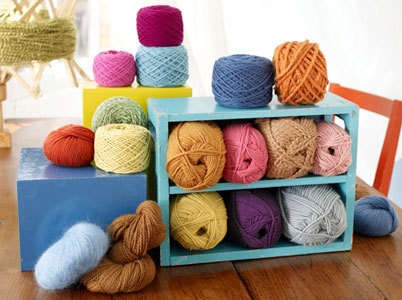It’s always frustrating to find a lovely pattern written for a yarn that has been discontinued, or one that you don’t particularly care for. One of the great things about knitting and crochet is that it’s very easy to use a yarn other than the one called for in the pattern. You can’t just swap any yarn into any pattern, though. Here are a few things you need to keep in mind:

Weight category: You will have much better luck substituting yarns of the same weight category. You’ll still need to make a gauge swatch (which you were going to do anyhow, right?), but you should be pretty close if you use the needle or hook size recommended by the pattern. And remember, it’s perfectly fine to adjust your needle size to get gauge. A trick for guessing at the weight category of older, discontinued yarns is to look at the needle size on the ball band – this will at least give you a place to start.
Fiber content: Different fibers work up differently. Your best bet is to substitute similar fibers: wool for wool, cotton for cotton, etc. You can substitute (for instance) cotton for wool, but you should be aware of the properties of both yarns (wool is springy and elastic, while cotton is neither) before deciding whether to do this.
Style of yarn: If you substitute a textured yarn for a smooth yarn, your project will be very different from the original. (Think about the difference between Homespun and Wool-Ease Chunky: two yarns in the same weight category, but of completely different styles.) This is absolutely okay, but something you should be aware of.
Actual weight: This doesn’t actually matter at all (unless you are making something very large and are concerned about the weight of the final object), and will not help you determine if you are purchasing enough yarn for the project or not. Say it with me: It’s all about the yardage. The reason this is true is that different fibers weigh different amounts. Cotton and silk, for instance, are much heavier than wool, so you’ll get much less yardage per pound. Acrylic can vary tremendously depending on the yarn construction. Go by yardage, not weight, and you’ll be fine.
When substituting yarns, the absolute most important thing you can do is your swatch. You are checking for gauge, for drape…for anything that will affect the quality of your finished project. Keeping the above guidelines in mind will help make your search for the perfect substitution much faster and more successful.
Gail Hollingsworth
What’s even worse to me…running out of the yarn you are using and then not being able to get more of the same color or lot! Then you have to rip out what you/ve already done and start over.
pat
After running out of yarn a few times I learned to buy extra. That is how my yarn stash was born. Of course now it includes yarn I fall in love with and need to find a suitable pattern. Someday I will get to use it all up,one for me, one for another, and a few for a good cause.
The “M” Word | Lion Brand Notebook
[…] my last post, I told you a bit about substituting yarns. I mentioned that you’re best off substituting a yarn that will give you the same gauge and […]
The “M” Word | Lion Brand Notebook
[…] my last post, I told you a bit about substituting yarns. I mentioned that you’re best off substituting a yarn that will give you the same gauge and […]
Elin Smith
When a pattern is written, does the designer include enough yardage in the listed requirements to make one or two swatches, or should we be buying extra? Thanks-
Fun to Knit, Fun to Wear | Lion Brand Notebook
[…] decided to substitute Hometown USA for the Wool-Ease Thick & Quick called for in the pattern, just because I know I […]
odette
Thanks for the answer to my question with this post. I will make copy and give
it to some of the gals who are working on this project.
Nada
Thanks so much for the tips, I usually find difficulty in choosing the right yarn for the pattern, especially when making a bag. Thanks againÂ
How to Read a Yarn Label | Lion Brand Notebook
[…] Choosing the Right Yarn […]